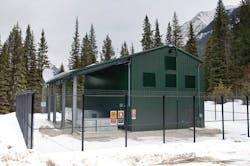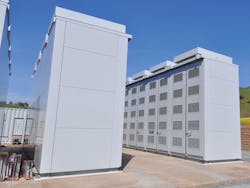After years of idling on the cutting-edge fringe of the electrical grid, energy storage is revving its engine, primed to take a run at securing a permanent and constructive slot in the global energy infrastructure. Storage’s long-awaited emergence comes amidst new and more pressing electrical generation and distribution challenges. And its rise is shadowing the virtuous-cycle script that many nascent technologies tend to follow in their rise to legitimacy.
Storage technology is maturing against a backdrop of mounting need for smarter energy resource management. Its transformation is being fueled partly by the competitive zeal of a growing number of players eager to stake out territory in a market brimming with potential. The end result is solutions whose costs are falling, making the potential cost-benefit scenario for users clearer. That, in turn, is sparking more demand, luring sideline-huggers into the market.
Factor in the impetus from renewable energy’s rise, the growing costs of adding more power generation, and harder nudges from a more prescriptive public sector, and the path to an energy storage breakout starts coming into view.
“Five years ago, no one talked about storage. A few years ago, it was just technology geeks. Now you’re starting to see people in Fortune magazine asking ‘what is going on with energy storage?’” says Troy Miller, director of grid solutions at Chicago-based S&C Electric Co.
Storage “is starting to get some legs underneath it,” he says, largely because the economics are starting to pencil out in a growing number of applications.
Miller’s view is supported by a surge of exhaustive research on the market. One reading of it is that storage is primed for a breakneck pace of deployment. Another is that growth is still dependent on a host of unknowns, notably the pace of advancements in technology, energy cost trends, and the payback equation.
In its U.S. Energy Storage Monitor report issued earlier this year, Energy Storage Association (ESA) and GTM Research forecast 250% growth in U.S. storage deployments during 2015. They say new storage projects brought 62MW online in 2014 — a 40% increase from 2013 — and were on track to total 220MW by 2015’s close. The report sees growth accelerating, reaching 861MW of newly installed capacity for 2019. That amount of added storage could be worth $1.5 billion. By comparison, the report gave the total amount of storage online in 2014 a value of $128 million.
Energy storage isn’t just a U.S. phenomenon. Global numbers from Navigant Research are bullish, too. Worldwide, it says, there were 363MW of energy storage projects announced in 2013-2014. Navigant sees global installed energy storage for the grid possibly hitting 21GW by 2024, and forecasts energy storage revenue hitting $15.6 billion by 2024, up from $675 million in 2014.
Falling battery prices
The falling cost to physically store energy is clearly green-lighting more projects. Battery storage, chiefly via lithium-ion (Li-ion) chemistry, is becoming cheaper to produce on a large scale. Batteries may account for half the cost of a system, so that decline erodes some initial investment costs. Moreover, advancements in technology are making those cheaper batteries more capable in a range of applications.
In another research paper it published earlier this year, Navigant stated that Li-ion battery technology has emerged as the “go-to choice for most stationary energy storage system developers.” Citing advancements that have improved the cost, energy density, efficiency, and safety profile of such batteries, Navigant sees the market reaching $16 billion by 2024, up from $775 million in 2015.
But the battery battle isn’t fully settled. Other technologies — some proven, others experimental — could challenge Li-ion. Sodium-sulfur, flow and lead-acid chemistries have made some inroads, and they’re being perfected, perhaps for application-specific purposes.
Batteries may well be on track to unseat pumped storage hydroelectric as the leading means of large, grid-scale storage. And they’re almost certainly the storage vehicle of the future for non-grid-scale deployments. Others, such as flywheel, thermal, power-to-gas, and compressed air energy, account for a fractional slice of installed storage and are a long shot to gain much traction. As batteries come of age, their ascension is sure to fuel a quickened pace of storage deployment.
“As lithium-ion costs come down — we’ve seen a factor of four decrease in price from just three or four years ago — people aren’t waiting to see what’s next with other chemistries that might even have a shot at displacing lithium-ion,” Miller says. “One of the key reasons we’re at an inflection point in storage is that storage has become a lot cheaper.”
Riding renewables
Renewable energy’s growth is another signal that more storage is coming. As more solar and wind generation comes online, the need for reliable and cost-effective methods of storing the produced electricity for optimal use later on is increasing. Storage is closely tracking renewable energy’s integration because it helps transition a highly intermittent, potentially grid-destabilizing energy source into a more predictable and manageable asset.
By linking conditions-dependent renewable energy production with a storage component, direct beneficiaries in the growing “behind-the-meter” commercial and industrial (C&I) storage market attack a constraining feature of renewable energy. As energy-intensive businesses in that C&I space site renewable energy projects, more are looking at storage as a way to gain flexibility by tapping into potentially cheaper power as needed. C&I market storage trends tell the story; deployments tripled from 2.1MW in 2013 to 6.4MW in 2014, says U.S. Energy Storage Monitor.
“In-front-of-the meter” storage gives grid operators like utilities and energy transmission entities a tool to expand and better leverage their own growing renewables portfolios. And, when it’s sited peripherally, grid-connected storage gives grid operators a way to manage an unpredictable and sometimes finicky energy source so it becomes a system-wide net asset rather than a liability.
Even storage not directly linked to renewable generation is gaining traction. Properly designed and integrated, it gives power marketers a tool for better managing supply and demand, and can serve as a buffer from potentially chaotic service disruptions tied to outages. As an energy bank, it can also serve to check growing capital outlays for new generating capacity needed to keep pace with growing demands for peaking power.
Matt Roberts, ESA executive director, attributes energy storage’s ascendance to a growing recognition of its practicality. With an electrical grid “50% overbuilt to accommodate 12 hours a year of ultra-high demand,” he says, storage may provide a solution that can be brought online much faster and cheaper than new generation.
“Energy storage is a solution that’s being sought out for some of the challenges we’re facing on the grid,” he says. “The two main ones are dealing with variability on the grid because of renewables or just because of a mismatch in generation and consumption, and the other one is reliability, wanting to have backup energy and using it as a resiliency tool for when the grid suffers some kind of event.”
Nudging growth
Those may be compelling reasons to deploy more “in-front-of-the-meter” storage amidst tumbling prices, but grid-scale projects may still need some impetus. That’s coming in various forms from some governmental entities.
In California, which leads the nation in renewables deployments, the Public Utilities Commission directed big investor-owned utilities, aggregators, and other energy service providers operating there to add 1.3GW of storage by 2020. Demonstrating the market’s appeal, a huge response greeted requests for offers. Pacific Gas & Electric reportedly received applications totaling 5,000MW, far above its 74MW mandate. And a state grid operator, California ISO, got applications for some 2,000MW of storage projects in 2014.
Meanwhile, agencies in other jurisdictions grappling with mounting electricity grid concerns are working to fertilize innovation in storage technology and deployment. The New York State Energy Research and Development Authority is funding work by New York Battery and Energy Storage Technology Consortium to explore development and commercialization of next-generation batteries and even entirely new energy storage mechanisms. In Massachusetts, the Department of Energy Resources and the Massachusetts Clean Energy Center is launching a multi-pronged Energy Storage Initiative. Its goal is to establish a framework for a comprehensive energy storage market structure encompassing utility, distribution, and customer applications.
Incentives are also pushing energy storage deployment. California has become a national leader in “behind-the-meter” installations, thanks partly to a Self-Generation Incentive Program (SGIP). The SGIP helps installers recoup 60% of eligible project costs, up to a maximum of $1.46 per watt of installed capacity. Around 5.7MW of “behind-the-meter” storage was installed in 2014 — good for some 90% of all that came online nationally.
Nudges and carrots have helped jump-start installations, but the real drivers of this storage boomlet probably lie elsewhere. Advances in the science and engineering of energy storage that allow its powers to more fully blossom are enhancing its value. It’s in this space — the design, installation, and application of complete storage solutions — where leading-edge companies can draft behind storage’s coming of age.
Smart storage
The emerging frontier in storage is smart, multi-functional systems. Solutions must increasingly provide for intelligent and creative management and oversight of the energy storage function. Systems so designed give storage a multi-dimensional value proposition that can maximize energy savings and efficiency.
But realizing storage’s full potential demands fresh thinking. Today, the market increasingly belongs to providers who understand its complexities and how to extract more value from it.
“What people like to think of this as is that essentially you pull Lego blocks off the shelf, and you snap them together, says Andy Tang, senior vice president of business development for Greensmith Energy Management Systems, Rockville, Md. “These systems are actually very complex.”
That reality may easily escape newcomers flooding into the storage solutions business, Tang says, a group increasingly populated by renewable energy systems companies. “It’s a logical progression for solar and wind guys to move into storage,” he says, “and there are some similarities but also key differences. The big one is that storage is a two-way asset, where wind and solar is one way.”
Navigating potholes
Critical in today’s evolving storage market, Tang says, is a deep understanding of the control function overlaying a robust storage system. A good control system helps users determine with more precision how to best manage storage assets.
A stubborn technical obstacle in storage’s path has been a communications barrier between storage components and control systems. A Modular Energy Storage Architecture (MESA) concept is a possible solution, and an industry group, MESA Standards Alliance, is spearheading development of an open set of specifications and standards that would streamline deployment of grid-scale storage systems.
But advances in developing the broad range of storage applications may be running a bit ahead of the ability to realize their full value in the evolving energy marketplace.
Jacqueline DeRosa, director of emerging technologies for Customized Energy Solutions, a Philadelphia-based company that consults on a growing number of storage projects, says more clarity is needed on the market rules for ensuring that those who bring storage assets into the mix have a shot at maximizing the return on their investment.
“From a grid perspective, the value streams for energy storage could be better defined,” she says. “Right now, the payment streams for various ancillary services are not market-based or transparent. For example, energy storage resources can provide frequency response and active power, but the rules for compensation are not fully developed. That’s an example of how the market design needs to evolve to provide more value to storage.”
That lag between technological innovation and how to make it pay for everyone — investors, vendors, and users — is a frustration shared by all next-generation energy solutions. Storage is hardly an exception, says ESA’s Roberts. Sometimes a generator, other times an energy-absorbing load and here and there a transmitter of energy — make storage a new animal. A chameleon, perhaps?
“Storage is a round peg trying to fit into a square hole in some ways,” he says. “The challenge is, when it’s being used in multiple functions, how you get remuneration for those services.”
Zind is a freelance writer based in Lee’s Summit, Mo. He can be reached at [email protected].
SIDEBAR: Storage Projects Present Challenges for Electrical Professionals
As technology-induced disruption scrambles standard business models and practices far and wide, energy storage is a concept very much in sync with the times. The growing ease of banking electrical power is a potential game changer, bringing a new dimension to the work of electrical professionals.
Batteries and renewable energy, microgrids, and distributed generation — they’re things that more contractors, systems designers, engineers, and plant personnel will bump into as stored energy becomes mainstream. Mostly, that translates to opportunity. As more energy-intensive businesses and energy providers ramp up storage, electrical contractors and engineers are in line to help shepherd the transformation.
“As storage becomes more scalable, electrical contractors are going to be seeing more behind-the-meter projects,” says Matt Roberts, executive director of Energy Storage Association, Washington, D.C. They’ll find work as part of multi-specialty teams headed by total-solution developers and specialists that pull projects together, Roberts says. Their work will encompass storage asset installation and grid interconnections, and demand familiarity with the impact of building and electrical safety codes and interconnection standards.
Working with batteries is also a new twist, and they present special concerns — among them safety. Batteries pose fire hazards that must be addressed in the installation, commissioning, and day-to-day operations. Contractors will need to understand the chemistry of different battery types and the safety and operational considerations they demand.
“Batteries are volatile instruments, and you want to make sure there are good built-in safety precautions, including controls that shut batteries down or physically disconnect them from the grid when they overheat and adequate fire suppression systems on-site,” says Andy Tang, senior vice president of business development with Greensmith Energy Management Systems, Rockville, Md., a storage systems designer.
Still, much heavy lifting in storage projects lies outside the core competencies of a typical electrical contractor. The all-important software-based control layer is designed by specialists. That’s sure to remain the case, especially as battery technology continues to evolve.
“We’re in a cycle now where every six to 12 months a manufacturer comes out with a new design or chemistry modification that tries to improve certain parameters,” Tang says. “We’ll continue to see that happen.”
For plant electrical operations and maintenance staff, on-site storage tied to renewable generation will be a new wrinkle. Managing it may grow even more complex as the scope of systems widens.
“One area we’re seeing some more growth is in the aggregated storage arena where smaller resources are combined to generate, store, and sell power into the market,” says Jacqueline DeRosa, director of emerging technologies for Customized Energy Solutions, a Philadelphia-based company in the storage system market.
Technology for behind-the-meter storage market also may be outrunning knowledge of how to structure deals. Les Sherman, an attorney with Orrick, Herrington & Sutcliffe LLP, a San Francisco law firm that has an energy practice, says energy storage contracts can be complex.
“Unlike solar or wind power purchase agreements, storage is a market where terminologies and standards are still developing, and that can complicate the process of devising contracts that govern the process,” he says.






